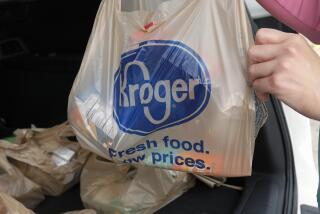Anaheim Convention of Processors : Buyout Frenzy Through ’89 Seen in Food Industry
- Share via
A flurry of big-name buyouts and mergers that began last year among U.S. food manufacturers should continue at the same frenzied pace in 1989, industry executives and financial experts said Tuesday in Anaheim.
With Wall Street money managers sitting in a $25-billion pool of investors’ funds, analysts believe that there is enough money available to fuel up to $250 billion in corporate buyouts.
“And you can bet some of that money is going to be used this year,” said Porter Morgan, vice president for marketing of the American Stock Exchange, speaking to 400 members of the National Assn. of Food Processors.
Morgan and a panel of food industry executives agreed that buyouts and mergers--such as the giant RJR Nabisco and Pillsbury deals--will continue at roughly the same pace as last year because big companies have found that it is cheaper to increase profits through mergers rather than make large investments in researching new products, modernized processing plants and market expansion.
Undervalued Stock Prices
In addition, most stock analysts believe that stock prices of some food companies are significantly undervalued, making them more attractive takeover targets for investors, Morgan said.
“That $25-billion equity pool is waiting, looking for a home. It is looking for the right deals,” Morgan said.
Even though the increased merger activity could rob the U.S. Treasury of tax dollars and research into new food products has slowed, most leveraged buyouts and mergers have improved the health of the companies involved and have not adversely affected consumers, he said.
Morgan backed that assessment with preliminary results of a survey in which the American Stock Exchange asked 70 middle-size companies involved in recent buyouts and mergers whether the deals turned out to be good for the company.
The vast majority, Morgan said, were as strong or stronger than before the merger and had not sold off assets or closed plants, debunking the myth that buyouts lead to layoffs and reduced productivity.
On the other hand, most of the companies said their research and development activities for new products had slowed because managers were more concerned with paying off huge debts incurred by the company in the buyout and merger process.
Roughly $100 billion was loaned by U.S. banks to leveraged buyouts and mergers in 1988, Morgan said.
“If there are too many defaults and failures after mergers, or if interest rates shoot up, the banks could be facing a crisis that could be called their next ‘Third World debt crisis,’ ” Morgan said. “I believe the Congress ought to look at the capital-gains issues.”
Because companies can write off some debt they incur in a buyout, the total loss to the country’s tax rolls could run into the billions of dollars, analysts said.
The downside, however, is not enough to discourage new mergers in the future. “They are lucrative, and how do you say no to a deal the size of RJR Nabisco?” Morgan asked, pointing out that bankers, brokers and lawyers will reap roughly $500 million in fees from that deal alone.
Some industry executives in Anaheim speculated that Gerber Products Inc. and Borden Inc. are likely 1989 takeover targets.
More to Read
Inside the business of entertainment
The Wide Shot brings you news, analysis and insights on everything from streaming wars to production — and what it all means for the future.
You may occasionally receive promotional content from the Los Angeles Times.










